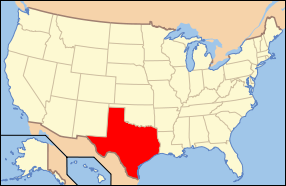Texas in the Civil War
| State of Texas | |||||
|---|---|---|---|---|---|
| Nickname(s): "The Lone Star State" 28th state of the United states of America | |||||
|
|||||
| Capital | Austin | ||||
| Largest City | Houston | ||||
| Admission to confederacy | March 2, 1861 (7th) | ||||
| Population |
|
||||
| Forces supplied | |||||
| Major garrisons/armories | Galveston Harbor | ||||
| Governor |
Sam Houston Edward Clark Francis Lubbock Pendleton Murrah |
||||
| Lieutenant Governor |
John McClannahan Crockett |
||||
| Senators |
William Simpson Oldham, Sr. Louis Trezevant Wigfall |
||||
| Representatives | List | ||||
| Restored to the Union | March 30, 1870 | ||||
The U.S. state of Texas declared its secession from the United States of America on February 1, 1861, and joined the Confederate States on March 2, 1861, after it replaced its governor, Sam Houston, when he refused to take an oath of allegiance to the Confederacy. As with those of other States, the Declaration was not recognized by the United States government at Washington. Some Texan military units fought in the Civil War east of the Mississippi River, but Texas was most useful for supplying soldiers and horses for Confederate forces. Texas' supply role lasted until mid-1863, after which time Union gunboats controlled the Mississippi River, making large transfers of men, horses or cattle impossible. Some cotton was sold in Mexico, but most of the crop became useless because of the Union naval blockade of Galveston, Houston, and other ports.
In the late winter of 1860, Texan counties sent delegates to a special convention to debate the merits of secession. The convention adopted an "Ordinance of Secession" by a vote of 166 to 8, which was ratified by a popular referendum on February 23.
Separately from the Ordinance of Secession, which was considered a legal document, Texas also issued a declaration of causes spelling out the rationale for declaring secession. The document specifies several reasons for secession, including its solidarity with its "sister slave-holding States," the U.S. government's inability to prevent Indian attacks, slave-stealing raids, and other border-crossing acts of banditry. It accuses northern politicians and abolitionists of committing a variety of outrages upon Texans. The bulk of the document offers justifications for slavery and white supremacy, saying that remaining a part of the United States would jeopardize the security of the two. The declaration includes this extract praising slavery, in which the Union itself is referred to as the "confederacy":
...
Wikipedia



